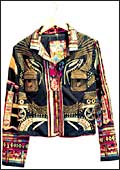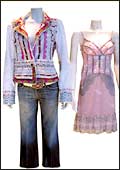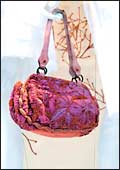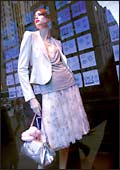|
For
the last two seasons, western fashion has been flirting with Indian
inspirations. However, this summer, at a time when India is being
touted as the next big economic powerhouse, it has emerged the
single largest influence in western fashion trends. From boutiques
to high-end departmental stores, even stores like Old Navy that
cater to the masses, Indian influences have run riot. And, it
is not just garments. Little India can be seen in accessories
like handbags, footwear, bangles and, of course, the hottest trend-chandelier
earrings.
In New York, starting on the southern fringes
of Central Park and window-shopping 20 blocks downtown along Fifth
Avenue, one is convinced that it is, in no uncertain terms, an
Indian summer. This stretch of real estate packs some of the trendiest
stores, a virtual Mecca for fashion retail ware. The showroom
windows are all about colour, sequins and intricate embroidery,
the leitmotif of Indian fashion.
At Bergdorf Goodman, the high-end fashion
store, the windows are aglow with designs inspired by Indian influences.
The south-side windows sport wares from Anna Sui, a washed denim
mini-skirt with silk and gold embroidery that sports sequins;
Diane von Furstenberg, a saffron silk and cotton capelet adorned
with gold sequins; and Roberto Rodriguez cotton skirts that sport
gota work from Rajasthan. On the east side of the store is a J
Mendel collection, including one by its design chief, Bibhu Mohapatra,
a grey broad-tailed coat with antique silver zardosi work running
along the length of the shoulders and priced at a whopping $50,000
(Rs 22,00,000).
 Across
the street at Louis Vuitton, the showroom window shows off a mannequin
in a cotton canvas skirt bearing metallic sequins and silk flowers.
Another five blocks east brings one to the Bloomingdale celebration
of Indian fashion. Just over a week ago, the windows sported skirts
that Jason Gautier designed after travelling to India and purveying
the traditional Rajasthani equivalents. Across
the street at Louis Vuitton, the showroom window shows off a mannequin
in a cotton canvas skirt bearing metallic sequins and silk flowers.
Another five blocks east brings one to the Bloomingdale celebration
of Indian fashion. Just over a week ago, the windows sported skirts
that Jason Gautier designed after travelling to India and purveying
the traditional Rajasthani equivalents.
Back on Fifth Avenue, even Saks has not been
spared. Located next to the historic St Patrick's cathedral, its
windows show off a host of designers, several of whom have clearly
been influenced by Indian influences. Standing out is a tulle
dress with black beads, gold sequins and embroidery, and an accessory
in the beaded purse. Then there is a Dolce & Gabbana spring
coat that sports intricate coral bead embroidery. And a Caroline
Herera tweed suit adorned with rhinestone embroidery and pearls.
"I think there are two things going
on here. First, lines are beginning to blur into a melting pot
of world fashion. It's not just Indian fashion that's suddenly
in vogue, but a mix of Indian, Latin, Asian, Greek, Russian, etc.
That said, rich accents of Indian colour, beading and embellishments
figured very strongly in Spring and Summer 2005 Collections,"
says Los Angles-based fashion expert Mary Jo Matsumoto.
 |
| India-inspired designs are all the rage
in the hip and trendy fashion stores of New York |
If seen in isolation, the emergence of Indian
influence in western fashion may seem surprising. However, it
is a phenomenon that is long overdue. Indian cultural wares began
to be showcased in a big way after the Broadway splash of Bombay
Dreams. Though the Andrew Lloyd Webber musical never got off to
the dream run that it enjoyed in London, it inadvertently set
in motion a process that gained momentum when the Presidential
elections of last November saw outsourcing to India as one bone
of contention between the two candidates. A Bush victory put the
seal on this debate and in many ways reinforced the shift in business
focus towards India. In other words, India's profile in popular
perception was undergoing a rapid shift, from a country ravaged
by poverty, yet replete with exotic elements to an economic powerhouse,
a vibrant democracy and a very multicultural society.
 |
| A Louis Vuitton skirt sporting sequins
and silk flowers |
A year ago, only the house of Armani was willing
to take the plunge outfitting the co-leads of Bombay Dreams in
attire clearly influenced by India. But by the time the Spring
2005 showings came up, circumstances had clearly changed. Designers
such as Oscar de la Renta and Zac Posen drew liberally from Indian
inspirations. Around the same time in Milan, the Armani's Emporio
range (younger urban line) for the season showed off an India-inspired
line. "The women's wear in the Emporio range of Armani was
inspired by India. We had women wearing Jodhpur salwars and turbans,"
says Atul Midha, a buyer for Emporio Armani.
For the discerning, however, the first hint
of change came two years ago when Lord and Taylor gave its shop
windows, that run almost block length, a complete makeover with
Indian couture. Inside the store, it followed up with an elaborate
creation of space, dubbing it "Into India Shop", for
a clutch of the top-of-the-line designers from India, including
Tarun Tahiliani, Manish Arora, Rina Dhaka and Vivek Narang.
| THAT BEADING THING |
 At
first sight, it would appear that Mystic Beading is just another
mailbox in the garment district of Manhattan that stretches
from the periphery of Times Square. Think again. It is an
address, like several other Indian-owned ventures in the garment
district, that is frequented by top-notch designers. At
first sight, it would appear that Mystic Beading is just another
mailbox in the garment district of Manhattan that stretches
from the periphery of Times Square. Think again. It is an
address, like several other Indian-owned ventures in the garment
district, that is frequented by top-notch designers.
"Earlier, only high-end designers used beading as
it was an expensive proposition. However, now with easy
access and sudden spurt in the number of players as well
as the upswing in fashion trends using beading, almost everyone
is into it," says Moon Ghera, co-owner of Mystic Beading.
The company, part of a family-owned enterprise that is
based in Mumbai, was set up 15 years ago to provide beading,
which is the term used in the trade for embroidery, sequin
work, zardosi, even feather work. Its clientele includes
Oscar de la Renta, Calvin Klein, Bill Blass, Armani and
J. Mendel.
By some estimates, incomplete work- beading, sequin work,
zardosi-worth $50 million (Rs 220 crore) a year is outsourced
to India. The numbers, however, are much more impressive
for complete garment work ($500 million or Rs 2,200 crore).
Still, few firms like Mystic Beading control about 90 per
cent of this kind of beading business that is being increasingly
sourced out to India. This has only got a fillip with designers
finding Indian craftsmen more skilled, even cost-competitive.
"The pricing has definitely dropped. Earlier, the
minimum cost would have been $100 (Rs 4,400) per yard and
would go up to $10,000 (Rs 4,40,000) a yard depending on
the work. Now, this range has dropped to $20 (Rs 880) to
$5,000 (Rs 2,20,000)," adds Ghera.
She also points out that Lucknow is emerging as a potential
rival to Mumbai. In fact, many new players who have joined
the business have bypassed the process of setting up in
Manhattan-and thereby shaved off the associated overheads-and
deal directly with the designers. It's the net, you see.
One of India's oldest industries has leveraged one of its
newest to good effect.
|
But at that time, the influences were much
more subtle. Dhaka's embellishments were minimal and Tahiliani
focussed on the subtle merging of modern cut with classic Indian
thought, as seen in his chikan creations and sheer net tunic paired
with pants.
 |
 |
"Earlier, Only high-end designers
used beading as it was expensive. Now, almost everyone is
into it"
MOON GHERA
CO-OWNER/MYSTIC BEADING |
"Indian influences have never been
so strong. It (mendel's spring 2005 collection) is the best
showing ever"
BIBHU MOHAPATRA
DESIGN CHIEF/
J MENDEL |
Two years is a long time in global fashion.
India turned a corner this spring in the West. Further, much of
the beading and embroidery work is now done out of India. In the
Spring 2005 Collection, a range of dresses inspired by Indian
colours and fabrics included the exquisite embroidery and beadwork
of regional artisans.
French fashion house J Mendel, which has
effected a major design overhaul under the aegis of Mohapatra,
for instance, outsourced its embroidery and zardosi work to India
for its Spring 2005 collection. "Indian influences have never
been so strong. It is the best showing ever," says Mohapatra.
Similarly, Zac Posen, considered by many
to be among the hottest young designers in the US, has drawn inspiration
from India for his 'tribalite' selection in the New York preview
that closed last week. Renta, who has long been inspired by India,
too employed Indian pink in his kaftaan range that was on display
at the show.
The perception in the fashion world is that
the Indian influence, despite its abrupt emergence, is part of
an overall trend. In almost every sphere-television, cinema, literature,
politics-the Indian influence is all too apparent. As a result,
it was only a matter of time before this influence spilled over
into the fickle world of fashion, goes the reasoning.
 |
 |
| Store windows are aglow with Indian couture
which has never been so haute |
A Saks Bag makes a splash with Indian embroidery |
"Coco Chanel once said that fashion has
to do with ideas, the way we live, what is happening. What's happening
now is that we live in a time when the world is becoming increasingly
connected. I feel that Indian fashion designers can be most successful
by embracing their uniqueness as well as being open to world trends
and fusing the two. This is a great opportunity for India to emerge
as a new major player in the global fashion world," says
Matsumoto.
The issue uppermost in people's mind is whether
the Indian influence is just a fad or whether it is part of a
trend and will eventually evolve and assume new forms in the world
of fashion. Those cued into the business believe that this is
just the beginning. But there are others who argue that the only
way Indian influence can be maintained is if Indian designers
make the global cut with very contemporary designs. The truth
may well lie somewhere in between. Till then, it is time to celebrate
the first ever Indian summer on Fifth Avenue.
|





 Across
the street at Louis Vuitton, the showroom window shows off a mannequin
in a cotton canvas skirt bearing metallic sequins and silk flowers.
Another five blocks east brings one to the Bloomingdale celebration
of Indian fashion. Just over a week ago, the windows sported skirts
that Jason Gautier designed after travelling to India and purveying
the traditional Rajasthani equivalents.
Across
the street at Louis Vuitton, the showroom window shows off a mannequin
in a cotton canvas skirt bearing metallic sequins and silk flowers.
Another five blocks east brings one to the Bloomingdale celebration
of Indian fashion. Just over a week ago, the windows sported skirts
that Jason Gautier designed after travelling to India and purveying
the traditional Rajasthani equivalents.

 At
first sight, it would appear that Mystic Beading is just another
mailbox in the garment district of Manhattan that stretches
from the periphery of Times Square. Think again. It is an
address, like several other Indian-owned ventures in the garment
district, that is frequented by top-notch designers.
At
first sight, it would appear that Mystic Beading is just another
mailbox in the garment district of Manhattan that stretches
from the periphery of Times Square. Think again. It is an
address, like several other Indian-owned ventures in the garment
district, that is frequented by top-notch designers.



